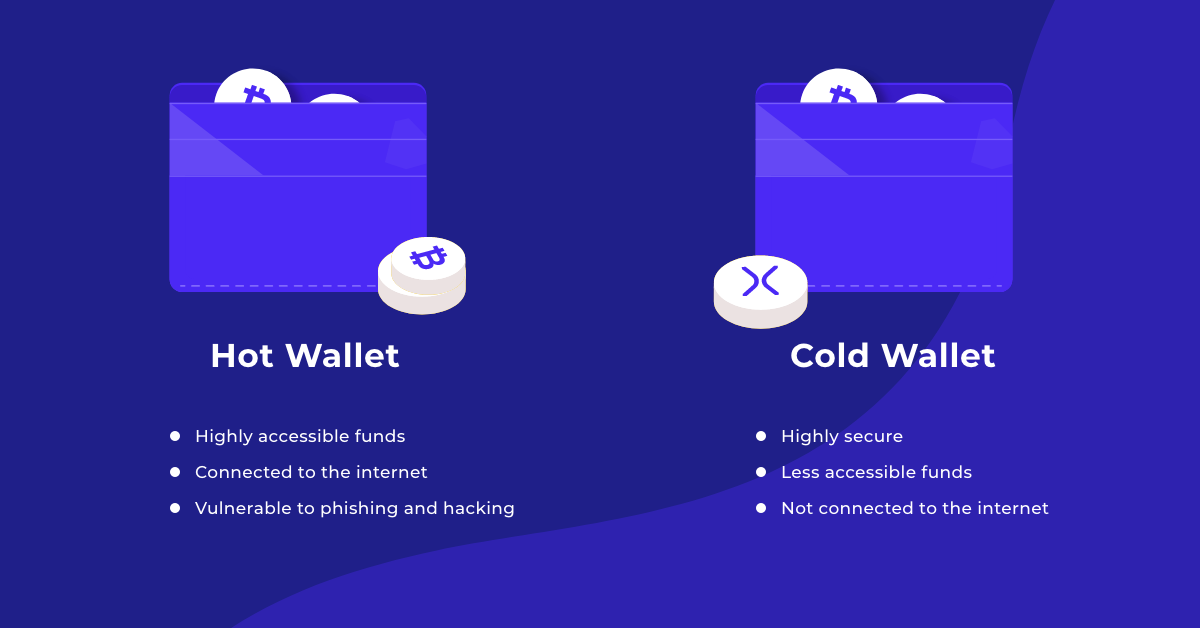What are the different types of cryptocurrency wallets?

What is a crypto wallet?
The majority of crypto wallet providers are based on software, which makes their use more convenient than hardware wallets. However, hardware wallets tend to be the most secure alternative. Paper wallets, on the other hand, consist of a « wallet » printed out on a piece of paper, but their use is now deemed as obsolete and unreliable.
How do cryptocurrency wallets work?
The wallet also includes an address, which is an alphanumeric identifier that is generated based on the public and private keys. Such an address is, in essence, a specific « location » on the blockchain to which coins can be sent to. This means you can share your address with others to receive funds, but you should never disclose your private key to anyone.
The private key gives access to your cryptocurrencies, regardless of which wallet you use. So even if your computer or smartphone gets compromised, you can still access your funds on another device – as long as you have the corresponding private key (or seed phrase). Note that the coins never truly leave the blockchain, they are just transferred from one address to another.
Hot vs. cold wallets
As mentioned, cryptocurrency wallets may also be defined as « hot » or « cold, » according to the way they operate.

Software wallets
Software wallets come in many different types, each with its own unique characteristics. Most of them are somehow connected to the Internet (hot wallets). The following are descriptions of some of the most common and important types: web, desktop, and mobile wallets.
Web wallets
You can use web wallets to access blockchains through a browser interface without having to download or install anything. This includes both exchange wallets and other browser-based wallet providers.
Desktop wallets
As the name implies, a desktop wallet is a software you download and execute locally on your computer. Unlike some web-based versions, desktop wallets give you full control over your keys and funds. When you generate a new desktop wallet, a file called « wallet.dat » will be stored locally on your computer. This file contains the private key information used to access your cryptocurrency addresses so you should encrypt it with a personal password.
If you encrypt your desktop wallet, you will be required to provide your password every time you run the software so that it can read the wallet.dat file. If you lose this file or forget your password, you will most likely lose access to your funds.
Therefore, it’s crucial to backup your wallet.dat file and keep it somewhere safe. Alternatively, you can export the corresponding private key or seed phrase. By doing so, you will be able to access your funds on other devices, in case your computer stops working or becomes inaccessible somehow.
In general, desktop wallets may be considered safer than most web versions, but it’s crucial to make sure your computer is clean of viruses and malware before setting up and using a cryptocurrency wallet.
Mobile wallets
Mobile wallets function much like their desktop counterparts but designed specifically as smartphone applications. These are quite convenient as they allow you to send and receive cryptocurrencies through the use of QR codes.
Hardware wallets
Hardware wallets are physical, electronic devices that use a random number generator (RNG) to generate public and private keys. The keys are then stored in the device itself, which isn’t connected to the Internet. As such, hardware storage constitutes a type of cold wallet and is deemed as one of the most secure alternatives.
While these wallets offer higher levels of security against online attacks, they may present risks if the firmware implementation is not done properly. Also, hardware wallets tend to be less user-friendly, and the funds are more difficult to access when compared to hot wallets.
Paper wallets
Some paper wallet websites allow you to download their code to generate new addresses and keys while being offline. As such, these wallets are highly resistant to online hacking attacks and may be considered an alternative to cold storage.
Owing to the numerous flaws, however, the use of paper wallets is now considered dangerous and should be discouraged. If you still want to use it, it’s essential to understand the risks. A major flaw of paper wallets is that they aren’t suitable for sending funds partially, but only its entire balance at once.
For example, imagine that you generated a paper wallet and sent multiple transactions to fund it, summing a total of 10 BTC. If you decide to spend 2 BTC, you should first send all 10 coins to another type of wallet (e.g., desktop wallet), and only then spend part of the funds (2 BTC). You can later return the 8 BTC to a new paper wallet, though a hardware or software wallet would be a better choice.
Technically, if you import your paper wallet private key into a desktop wallet and spend just part of the funds, the remaining coins will be sent to a « change address » that is automatically generated by the Bitcoin protocol. If you don’t manually set the change address to one that you control, you will likely lose your funds.
Most software wallets today will handle the change for you, sending the remaining coins to an address that is part of your wallet. But the important thing to remember is that your paper wallet will be empty after sending its first transaction out – regardless of the amount. So don’t expect to reuse it later.
The importance of backups
Losing access to your cryptocurrency wallets can be quite costly. So it’s important to back up them regularly. In many cases, this is achieved by simply backing up wallet.dat files or seed phrases. Essentially, a seed phrase works like a root key that generates and gives access to all keys and addresses in a crypto wallet. Also, if you opted for password encryption, remember to back up your password as well.

